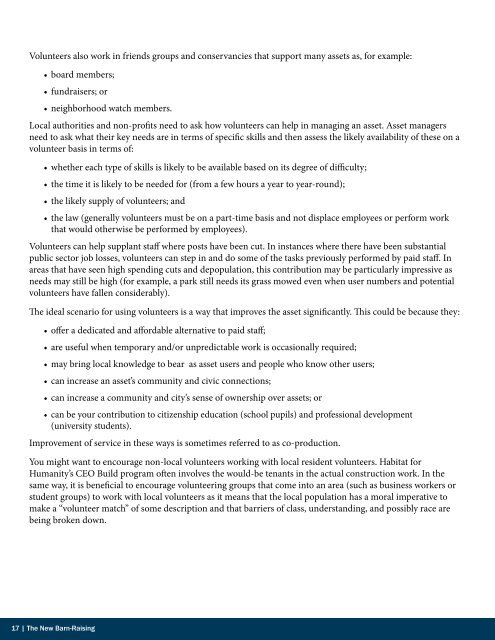bQNs7mR
bQNs7mR
bQNs7mR
You also want an ePaper? Increase the reach of your titles
YUMPU automatically turns print PDFs into web optimized ePapers that Google loves.
Volunteers also work in friends groups and conservancies that support many assets as, for example:<br />
• board members;<br />
• fundraisers; or<br />
• neighborhood watch members.<br />
Local authorities and non-profits need to ask how volunteers can help in managing an asset. Asset managers<br />
need to ask what their key needs are in terms of specific skills and then assess the likely availability of these on a<br />
volunteer basis in terms of:<br />
• whether each type of skills is likely to be available based on its degree of difficulty;<br />
• the time it is likely to be needed for (from a few hours a year to year-round);<br />
• the likely supply of volunteers; and<br />
• the law (generally volunteers must be on a part-time basis and not displace employees or perform work<br />
that would otherwise be performed by employees).<br />
Volunteers can help supplant staff where posts have been cut. In instances where there have been substantial<br />
public sector job losses, volunteers can step in and do some of the tasks previously performed by paid staff. In<br />
areas that have seen high spending cuts and depopulation, this contribution may be particularly impressive as<br />
needs may still be high (for example, a park still needs its grass mowed even when user numbers and potential<br />
volunteers have fallen considerably).<br />
The ideal scenario for using volunteers is a way that improves the asset significantly. This could be because they:<br />
• offer a dedicated and affordable alternative to paid staff;<br />
• are useful when temporary and/or unpredictable work is occasionally required;<br />
• may bring local knowledge to bear as asset users and people who know other users;<br />
• can increase an asset’s community and civic connections;<br />
• can increase a community and city’s sense of ownership over assets; or<br />
• can be your contribution to citizenship education (school pupils) and professional development<br />
(university students).<br />
Improvement of service in these ways is sometimes referred to as co-production.<br />
You might want to encourage non-local volunteers working with local resident volunteers. Habitat for<br />
Humanity’s CEO Build program often involves the would-be tenants in the actual construction work. In the<br />
same way, it is beneficial to encourage volunteering groups that come into an area (such as business workers or<br />
student groups) to work with local volunteers as it means that the local population has a moral imperative to<br />
make a “volunteer match” of some description and that barriers of class, understanding, and possibly race are<br />
being broken down.<br />
17 | The New Barn-Raising


